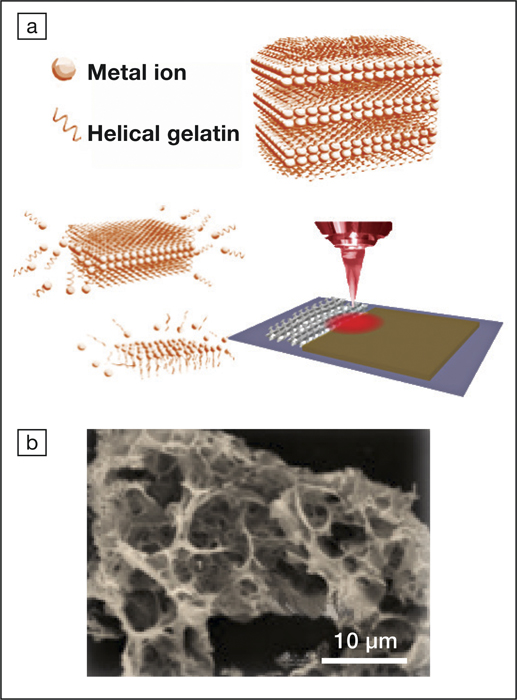Reducing a bulk material into a two-dimensional (2D) structure can significantly alter its properties and functionality by dramatically increasing the surface area-to-volume ratio. Ultrathin 2D transition-metal carbides (TMCs) have garnered significant interest for their advantageous electrical, thermal, and catalytic properties; however, commercialization of these materials has been difficult due to the lack of a cost-effective, large-scale fabrication method. Through a collaboration between Liwei Lin at the University of California, Berkeley, and Jeffrey Grossman at the Massachusetts Institute of Technology, a laser-based technique for the manufacture of ultrathin carbides has been developed. These findings were reported in a recent issue of Nature Communications (doi:10.1038/s41467-019-10999-z).

(a) Schematic of laser-sculptured ultrathin transition-metal carbide. Helical polymer gelatin and transition-metal ions (metallo-hydrogel) self-assemble into a layer-by-layer structure, which is then carbonized by a commercial laser with up to 25-µm resolution. (b) Scanning electron micrograph of laser-structured, porous MoCx with a connected curved surface. Credit: Nature Communications.
Previous ultrathin 2D-TMC synthesis methods use extremely high temperatures (up to 1600°C) and hydrofluoric acid. The researchers have developed a robust, mild-temperature fabrication method. They combined gelatin with carbide-forming metal ions (Mo5+, W6+, Co2+) to produce a layered metallo-hydrogel with a regular, self-assembled structure. This gel can be easily spin-coated onto a variety of substrates including glass slides. A commercial laser was then used to carbonize the layers (by local heating) to produce ultrathin TMC flakes with thicknesses of only a few nanometers. Since the laser selectively heats the gel to induce carbonization, the technique can directly pattern ultrathin 2D TMCs with up to 25-µm resolution and achieve conductivities of up to 300 S cm–1 in the carbonized regions, which is comparable with other carbon-based materials. Additionally, the extremely high local temperatures (greater than 2300°C) from the laser allows for the fabrication of higher energy metal carbide phases (e.g., α-MoC). In order to successfully control the production of metal, metal oxide, and metal carbide phases, the researchers balanced the energy absorption of the metal-gelatin template with the activation energy of carbonization for different combinations of metal ion, hydrogel medium, and laser wavelength.
“Patterning of surfaces becomes an important technique as devices need to be produced directly on a variety of substrates for [the] Internet of Things and emerging microelectronic applications. This work opens new opportunities in manufacturing microscale patterns, films, and entire devices for advanced technology,” says Yury Gogotsi, professor at Drexel University unaffiliated with the work, whose group research interests range from novel 2D structures to the integration of 2D materials in applications such as ultrathin electromagnetic interface shielding, water purification, and soft robotics.
To demonstrate the potential energy storage and energy harvesting capabilities of the ultrathin 2D TMCs, Lin and Grossman’s research group created flexible supercapacitors and solar-energy harvesting membranes using the laser-sculpted metal carbides. The supercapacitor has an operating temperature range of –50°C to 300°C; high cyclability of over 10,000 cycles; and could be easily fabricated by direct patterning onto a polyimide substrate. The solar-energy harvesting membrane takes advantage of naturally forming, interconnected surfaces in the laser-sculpted carbides to improve light capture and steam production with up to 73% efficiency. The ability of both devices to operate in harsh environments (e.g., high-temperature or highly corrosive) where other structures might fail provides an additional rationale for the use of these ultrathin 2D TMCs in applications such as oil and gas separators in aircraft engines or temperature-insensitive energy-storage devices.
This work represents a step forward to the large-scale, controllable synthesis of materials with unique 2D architectures, according to the research team. Gogotsi mentions that more research needs to be done to fully understand the synthesis–structure–property relationships of these metal carbides to precisely control the pore size and thickness and ultimately tune the materials properties. However, the ease and scalability of the laser ablation technique, according to the research team, offers a promising solution for more advanced materials fabrication, in competition with three-dimensional printing or additive manufacturing.
“Laser-based materials design provides a new, innovative approach to design a wide range of high-performance materials, such as refractory oxides and carbides as well as high-entropy alloy materials with ultrahigh hardness,” says Xining Zang, first author of the work. The resulting materials can then be used for a variety of applications, with Lin’s group investigating the use of lasers for the design of carbon-based electrodes for stretchable devices and Grossman’s group focusing on using lasers to engineer natural carbonaceous materials for electronics and conductive membranes.


